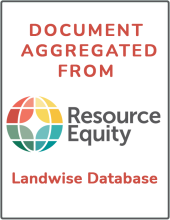Land Library Search
Through our robust search engine, you can search for any item of the over 73,000 highly curated resources in the Land Library.
If you would like to find an overview of what is possible, feel free to peruse the Search Guide.
/ library resources
Showing items 1 through 9 of 680.A review of a book on land in Kenya published in 2020 by Boydell and Brewer Ltd. The reviewer offers a detailed analysis and discussion of the 8 chapters of this 224-page book.
This article argues that while we know that the demand for land and natural resources has significantly accelerated in the last decade;it remains very difficult to gauge the exact size of the land rush. Many studies that look into how much land is affected give vastly diverging numbers.
Africa’s Catholic bishops have criticized the appropriation of land;natural resources and other economic assets by private companies and called on national governments to show greater concern for local community rights and needs.
Post-Soviet reforms in Kyrgyzstan during the 1990s and early 2000s included the allocation of land for long time use and eventual ownership to residents. 75% of arable land, including over 1 million hectares of agriculture land was distributed during this period.
Do Land Rights Formalization Interventions Work for Women?
Digital technologies cut off access to land
Despite promises to fix unjust land governance, a new study shows that digital technologies can further land grabbing and inequality.
In the western Algerian steppe, the public authorities have carried out actions aimed at rural development (agricultural development programs) and combating desertification (grazing reserves) to counter the significant and rapid loss of vegetation cover of pastures by overgrazing, and the consequ
Ordinary Malawians who live in customary land have been suffering from land grabbing due to their weak and ill-defined land rights.
Farmers’ satisfaction with reform of the land expropriation system has not been fully examined, so it is difficult to comprehensively and successfully judge the effectiveness of the reforms. Traditional statistical methods cannot accurately explain the relationship between the variables.






